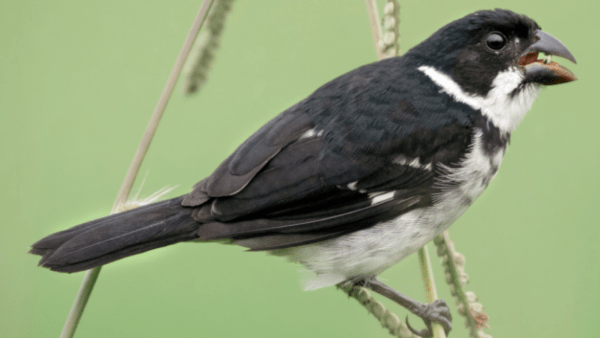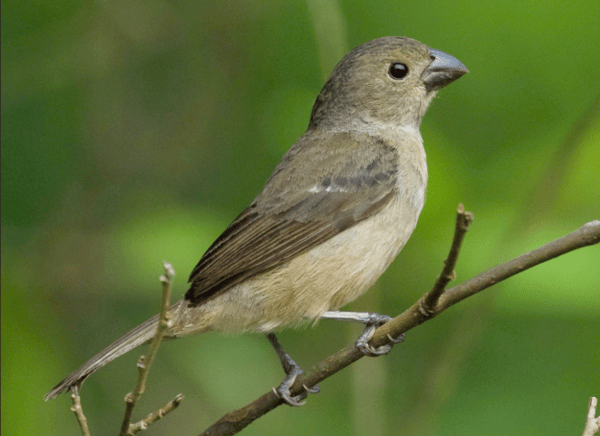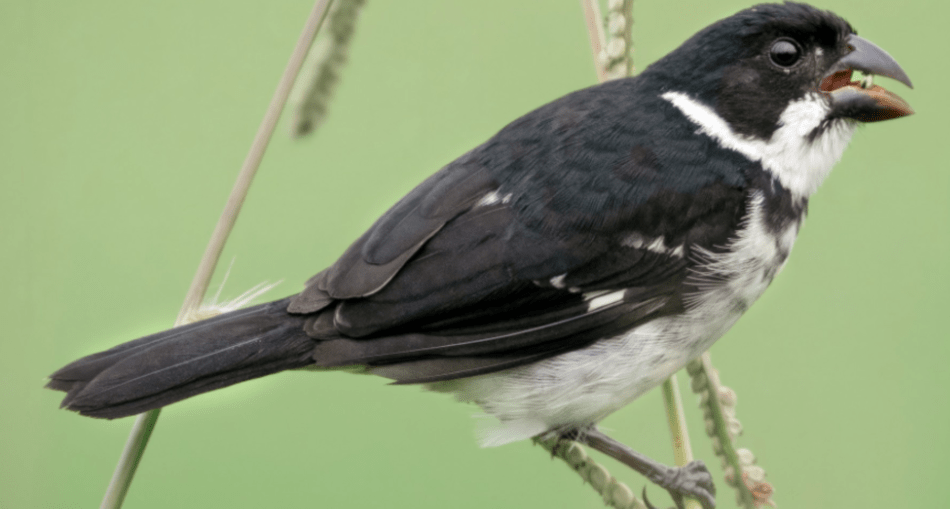The wing-barred seedeater (Sporophila americana) is a bird that can be found in the coastal regions of northeastern South America, including Guyana.

The male Wing-barred Seedeater [Photo: ergio Andrés Cuéllar Ramírez]
PHYSICAL CHARACTERISTICS AND IDENTIFICATION
The wing-barred seedeater is a small passerine bird, about 11 cm (4.25 inches) in length.
Its most recognisable features are its thick, black bill and the striking white wing bars, which give the species its name.
Males of the species are especially eye-catching, with black upperparts, a black pectoral collar, and white underparts.
Their wing bars contrast sharply against their black plumage, and their heavy black bill is perfect for cracking seeds.
The male’s distinct appearance can vary slightly depending on the region, but in northeastern South America, where Guyana is located, they often display a pale body with a dark breastband.
Females, on the other hand, are far duller, with buffy-olive upperparts and pale olive-ochre underparts. Their brownish bills and nondescript colouring make them more challenging to identify, blending in with other female seedeaters in the region.
HABITAT AND DISTRIBUTION IN GUYANA
In Guyana, the wing-barred seedeater inhabits a variety of semi-open environments, making its home in grassy areas, river edges, and scrubby fields.
It is usually found in pairs or small flocks, feeding primarily on seeds but sometimes also consuming buds, flowers, and fruits.
These habitats are especially common in Guyana’s coastal plains and forest edges, areas that offer the perfect mix of open spaces and vegetation for this bird to thrive.

The female Wing-barred Seedeater [Photo: David Ascanio]
This is largely due to human activity, particularly the trapping of seedeaters for the wild bird trade.
In many parts of the world, seedeaters are captured for their beauty and song.
According to BirdLife International and the IUCN, the wing-barred seedeater is categorised as a species of Least Concern, mainly due to its widespread population across northeastern South America.
IMPORTANCE OF THE WING-BARRED SEEDEATER TO GUYANA’S ECOSYSTEM
While small in size, the wing-barred seedeater plays a vital role in its ecosystem.
As a seed-eating bird, it aids in seed dispersal, which contributes to the regeneration of plant life in its habitat.
This function is crucial for maintaining the health of Guyana’s natural landscapes, from its coastal plains to inland grasslands.
By moving between feeding areas, the seedeater also helps maintain the ecological balance by controlling seed populations, which can prevent the overgrowth of certain plants and maintain biodiversity.
BIRDWATCHING IN GUYANA
For bird enthusiasts visiting Guyana, spotting the wing-barred seedeater can be an exciting experience.
With over 800 species of birds in the country, birdwatchers can explore various regions, including the Essequibo River, Iwokrama Rainforest, and Kaieteur National Park, in search of this and other unique species.
While the males are easier to identify due to their bold markings, patience is required to spot the more elusive females.
Birdwatchers are advised to look for pairs or small flocks and observe areas with abundant grass and shrubs.
References
- https://en.wikipedia.org/wiki/Wing-barred_seedeater
- https://birdsoftheworld.org/bow/species/wibsee1/cur/introduction
- https://ebird.org/species/wibsee1/CO







